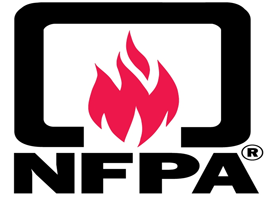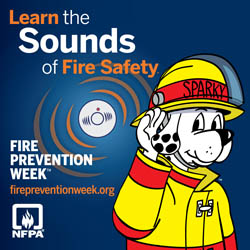The NFPA sponsors the observance of Fire Prevention Week to commemorate the Great Chicago Fire, which began Oct. 8, 1871. More than 250 people were killed and 100,000 were left homeless. The National Fire Protection Association uses the week to bring attention to the dangers of home fires. United States fire departments respond to an average of a home fire every 86 seconds.
- Between 2011 and 2015, U.S. fire departments responded to an average of 358,500 home structure fires per year. These fires caused 12,300 civilian injuries, 2,510 civilian deaths and $6.7 billion in damage.
- On average, seven people per day die in U.S. home fires.
- Cooking is the leading cause of home fires and home fire injuries.
- For decades, smoking has been the leading cause of home fire deaths.
- Heating equipment was involved in one in five deaths.
- According to an NFPA survey, only one in every three American households has developed and practiced an escape plan.
- While 71 percent of Americans have an escape plan, only 47 percent have practiced it.
Fire safety for hearing impaired individuals and elderly individuals
Choose smoke alarms and accessories listed by a qualified testing laboratory for deaf or hearing impaired people. In addition, it is a good practice to sleep with mobile phone and hearing aids near your bed.
There are smoke alarms and alert devices that alert people who are hearing impaired. These devices include strobe lights that flash to alert people when the smoke alarm sounds. Pillow or bed shakers that work with smoke alarms can also be installed. These work by shaking the pillow or bed when the smoke alarm sounds.
- Install a bedside alert device that responds to the sound of the smoke and CO alarms. In addition, the use of a low-frequency alarm can wake a person with mild to severe hearing loss.
- Sleep with mobility device, glasses and phone close to your bed.
- Keep pathways lit and free from clutter to make sure everyone can get out.
Smoke alarms
- Smoke alarms provide early warning, giving people additional time to escape.
- Working smoke alarms cut the risk of dying in a reported home fires in half.
- Three in five home fire deaths result from fires in homes without smoke alarms or no working smoke alarms.
- When smoke alarms fail, it is usually because batteries are missing, disconnected, or dead. Interconnected alarms throughout the home increase safety. When one sounds, they all sound.
Cooking
- Cooking is tied for the second leading cause of home fire deaths.
- Unattended cooking is the leading factor contributing to these fires. Frying poses the greatest risk.
- Ranges or cooktops accounted for 62 percent of home incidents. Ovens accounted for 13 percent.
- More than half of all cooking fire injuries occurred when people tried to fight the fires themselves.
- Thanksgiving is the peak day for home cooking fires. Next are the day before Thanksgiving, Christmas Day, Easter and Christmas.
Heating equipment
- The leading factor contributing to home-heating fires (30 percent) was a failure to clean. This usually involved creosote buildup in chimneys.
- Most home-heating fire-related deaths (84 percent) involved stationary or portable heaters.
- Nearly half of all home-heating fires occur in December, January and February.
Sprinklers
- Fire sprinklers reduce the risk of dying in a home fire by 80 percent. And, sprinklers reduce the risk of property loss by 70 percent.
- Sprinkler installation in new homes is cost-effective. It averages 1-2 percent of the construction cost.
- Sprinklers protect lives by keeping fires small. In addition, they can reduce the heat, flames and smoke.
- Sprinklers activate individually. Only the sprinkler closest to the fire will activate.
- A home sprinkler can control or extinguish fires. And, they use a fraction of the water that would be used by FD hoses.
- Install sprinklers in new or existing homes. Additionally, sprinklers work along with smoke alarms to save lives.
Source: https://www.nfpa.org/Public-Education/Campaigns/Fire-Prevention-Week/Fire-Facts


